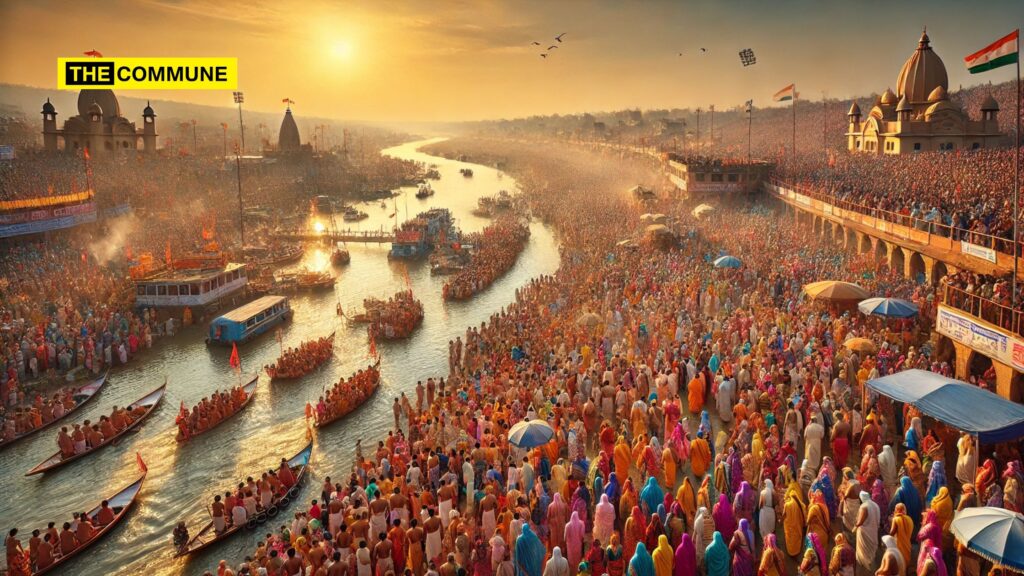A reference to the churning of the milky ocean which is responsible for the Kumbh Mela can be found in the Vishnu Purana. A pot of nectar came out when Samudra Mandhan happened. The Devas ran with the pot of nectar to prevent the Asuras from drinking the nectar. The demons also ran after them. While they ran, the droplets of nectar are spilled out at places like Prayagraj, Haridwar, Ujjain, and Nashik where the Kumbh Mela is performed.
It is mentioned in various ithihasa and Puranas. Adhyaya 103 to 113 in Mathsya Purana has Prayaga Mahathmyam where there are discussions about triveni snan.
In the 16th adhyaya of Srusti kandam from Padma purana, the 35th verse states:
triśu stāleśu yā: snāyata prayāke sa puṣkare|
kurukṣetre sathāramātmā sa yādi paramaṃ padaṃ||
Those who take the holy bath at places like Prayagraj, Kurukshethram, and Pushkar will attain the highest place which is Paramapadham.
The meaning of the above sloka is that they will get Moksha.
In Garuda Puranam, both Theertha Mahathmyam and Snana Mahathmyam mention various theerthams and their glory and the good deeds attained through the holy bath in those rivers.
agniṣṭomasahasrāṇi vājabeyasadāni sā|
kumbasnānasya kalanarahamde śodāsīmābi||
Its supreme glory can be discerned by the fact that even thousands of Agnishtomas and hundreds of Vajpayee yagas are not equal to one-sixteenth of a Kumbha bath and with this verse, we can understand the glory of the holy bath at Kumbh Mela.
Prayagraj is the confluence of the Ganga, Yamuna, and Saraswati rivers, where the Kumbh Mela is celebrated every 12 years. It is a site of spiritual significance. It is believed to remove sins and lead to moksha.
The Brahma Kanda of the Brahma-Vaivartha Purana mentions the importance of various holy places and various rituals at various times and places.
prayāke magmase du snāthvāpārṭivamardana:|
sarvapabāī: pramucyetā pitṛpi: saha modāte | |
That is, bathing in Prayagraj in the month of Magh is freed from all sins and their ancestors are happy.
kumbe kumpotabhava: snādva prāyacati hi manavāna|
dādā parāṇa na bābanī diṣṭantiśubakarmaṇam||
It means bathing in Kumbh leads to freedom from sins and good deeds.
kumbe kumpotabhava: snādva – Bathing during the Kumbh Mela is associated with the amrita that came out of the milky ocean.
prāyacati hi manavān – Provides purifying benefits to humans (devotees).
thādhā parāṇ na pāpanī diṣṭantiśubakarmaṇam – After that, those who do pious deeds will have no sin. This verse emphasizes that bathing during the Kumbh Mela purifies individuals, destroys their sins, and leads them toward virtuous deeds. This is a verse from Agni Purana.
Padma Purana, Uttara Kandam Chapter 112, Sloka 16:
tattarāpi yaha snānakrūta puṇyakale|
gaṃgā jalātirathamādivasaṃ||
puṇyaṃ labetha krūtakrūtya: sa katva|
vaikuṇḍaloka paramaṇ samedhi||
That is, one who takes a bath in the Ganges during the auspicious season attains auspiciousness and goes to Vaikunta Loka.
It is in the Padma Purana that Lord Shiva explains to Parvati the greatness of the Ganges and the spiritual benefits of bathing in its waters, especially during auspicious times, highlighting its power to confer suddhi and mukti.
Bhavishya Purana (Pratisarka Parva, Part 3, Chapter 7, Slokam 37-38):
kumbaraśiṃ mayi prabte gaṃgādvāre mahotsava:|
papuvā pahulairbubāī: karitastīrthātparai:||
When the Sun enters the sign of Aquarius, a great festival is held for the pilgrimage to Haridwar on the Ganges. This verse highlights the astrological significance of the Kumbha Mela in Haridwar, which is celebrated when the Sun moves into the sign of Aquarius.
Vana Parva of Mahabharata has a subsidiary Parva called ‘Tirtha-yatra Parva’. It mentions various Tirtha Yatra benefits.
tripuraṃ tahade yajñaṃ snānaṃ thīrathe du tahade|
sarvapāpaṃ sa tīrthe snāthvasarvaṃ bhavatī śudaye||
Sage Lomasha accompanies the Pandavas during their exile and narrates stories of various holy places (theerthas) to encourage them to undertake the pilgrimage. In this chapter, he describes the power of holy theerthas and the virtues that can be attained by bathing in them.
Through this verse, Lomasha emphasizes the spiritual importance of visiting Tirthas. He compares the suddhi effects of yagas (sacrificial rites) to the simple and equally powerful act of bathing in holy water, which purifies all sins and leads to ultimate purity.
This teaching is intended to inspire Yudhishthira and the Pandavas to undertake their pilgrimage with devotion and faith.
Vishnu Purana, Chapter 16, 6th Sloka:
ayaṃg kumbahaṃ paraṃ puṇyaṃ snānaṃ yena kṛtaṃ subhama|
sarvabāpakṣayasa yadi kacade viṣṇusannidhiṃ||
Bathing in Kumbh Mela is very sacred and one goes to Vishnu Lokam. Sri Vishnu Purana mentions that Vaikunta Loka is the highest loka to be reached by taking this Kumbha Mela bath.
Maha Kumbh Mela is a spiritual event steeped in culture and history. Hidden spiritual aspects enhance the experience of people who gather to participate in this sacred event. From the above slokas, it can be understood that Kumbh Mela helps people for spiritual development and attain moksha.
Let us elevate our spirituality and culture by participating in the once-in-a-lifetime event called Kumbh Mela.
G. Prasanna Venkatesan writes on Bharathiya knowledge, Sri Vaishnavism, Puranic and Ithihasa themes, and stories centered on national and social development.
Subscribe to our channels on Telegram, WhatsApp, and Instagram and get the best stories of the day delivered to you personally.

